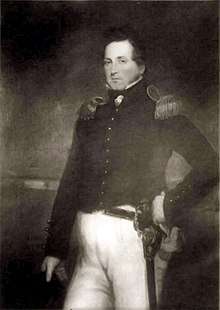Henry Atkinson (soldier)
Henry Atkinson (1782 – June 14, 1842) was a United States army officer. He was a native of Person County, North Carolina.
Henry Atkinson | |
|---|---|
 | |
| Born | 1782 Person County, North Carolina |
| Died | June 14, 1842 (aged 60) Jefferson Barracks, Missouri |
| Buried | Cave Hill Cemetery, Louisville, Kentucky |
| Allegiance | United States |
| Service/ | United States Army |
| Years of service | 1808 - 1842 |
| Rank | Colonel 1813 Brevet Brigadier General 1820 |
| Spouse(s) | Mary Ann Bullitt 1826 |
Early career
He entered the United States Army in 1808 as a captain in the infantry, serving at various outposts on the Western frontier. He moved to New York and was promoted to colonel in the Regular Army, seeing considerable action during the War of 1812. He commanded the 6th U.S. Infantry from 1815 until his death.
Career after War of 1812
After the war, Atkinson led two expeditions to the Yellowstone River in 1819 and 1825. Appointed Commissioner together with Indian agent Benjamin O'Fallon and with a military escort of 476 men, General Atkinson and his fellow commissioner left Fort Atkinson on May 16, 1825, and ascending the Missouri, negotiated treaties of friendship and trade with tribes of the upper Missouri, including the Arikara, the Cheyenne, the Crow, the Mandan, the Ponca, and several bands of the Sioux. At that time, there was still rivalry with British traders on the upper Missouri.
The treaties acknowledged that the tribes lived within the United States, vowed perpetual friendship, and recognized the right of the United States to regulate trade, promising to deal only with licensed traders. The tribes agreed to forswear private retaliation for injuries and to return or indemnify the owner of stolen horses or other goods. Efforts to contact the Blackfoot and the Assiniboine were unsuccessful. Returning to Fort Atkinson at the "Council Bluff" in Nebraska, successful negotiations were had with the Otoe, the Pawnee and the Omaha.[1]
He was appointed brevet brigadier general and was in overall command of U.S. forces during the Black Hawk War. Although he delivered the final blow to the Black Hawk Indians at the Battle of Bad Axe, Atkinson was criticized for mishandling the operations of the war and his reputation did not prosper as did those of his subordinates Zachary Taylor and Henry Dodge.
Atkinson later superintended removal of the Winnebago to Iowa; a second Fort Atkinson was named in his honor in Iowa. The City of Fort Atkinson in Jefferson County, Wisconsin is also named after him. Jefferson Barracks (near St. Louis) and Fort Leavenworth were begun under his direction. He spent the remainder of his career stationed at Jefferson Barracks.[2]
Personal life
He married Mary Ann Bullitt on January 16, 1826. They had a son, named Edward Graham Atkinson.[2]
Death
He died at Jefferson Barracks, Missouri on June 14, 1842.[2]
Locations named for Henry Atkinson
- Fort Atkinson, Iowa, a town in Iowa
- Fort Atkinson State Preserve, 1840s U.S. Army post in Fort Atkinson, Iowa
- Fort Atkinson (Nebraska), 1820s U.S. Army post in Nebraska
- Fort Atkinson, Wisconsin, a city and fort in Wisconsin[3]
Notes
- Page 143, American Indian treaties: the history of a political anomaly by Francis Paul Prucha, University of California Press (March 15, 1997), trade paperback, 562 pages ISBN 0-520-20895-1 ISBN 978-0520208957
- Who Was Who in American History - the Military. Chicago: Marquis Who's Who. 1975. p. 18. ISBN 0837932017.
- Gannett, Henry (1905). The Origin of Certain Place Names in the United States. Govt. Print. Off. pp. 128.
References
- Nichols, Roger L. General Henry Atkinson: A Western Military Career. Norman: University of Oklahoma Press, 1965. OCLC 175833
- Ghent, W. J. "Atkinson, Henry." Dictionary of American Biography. Vol. 1, Charles Scribner's Sons. 1928.